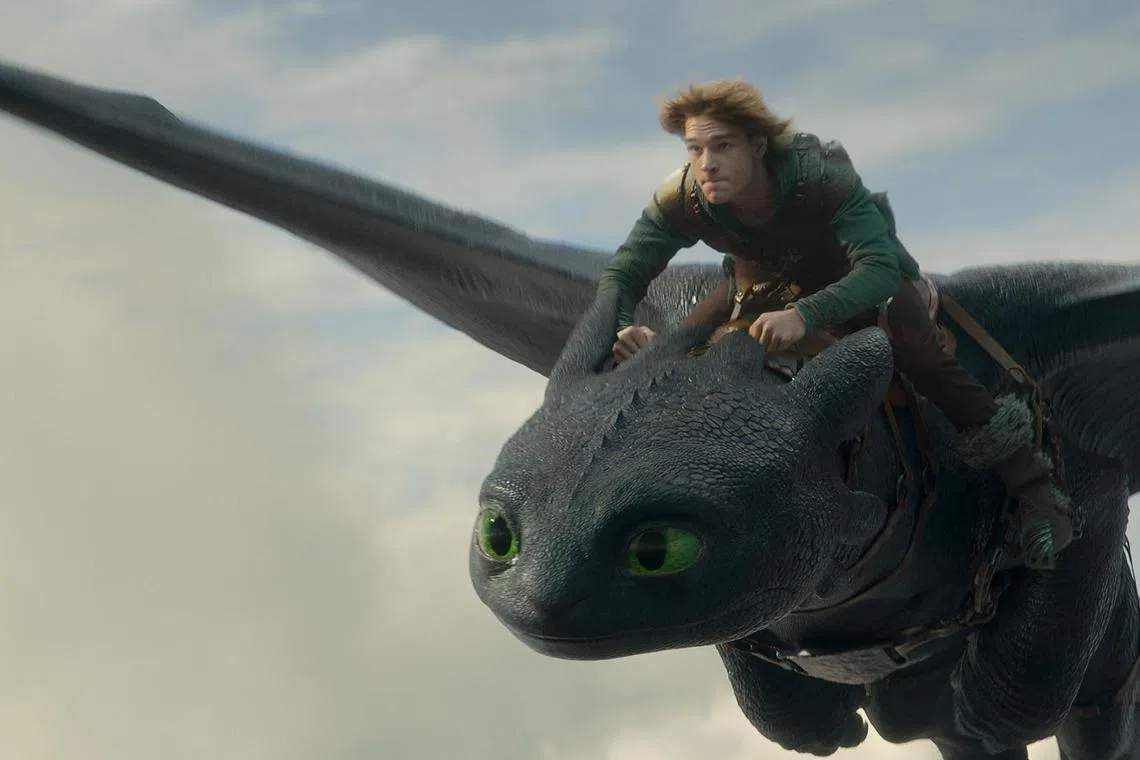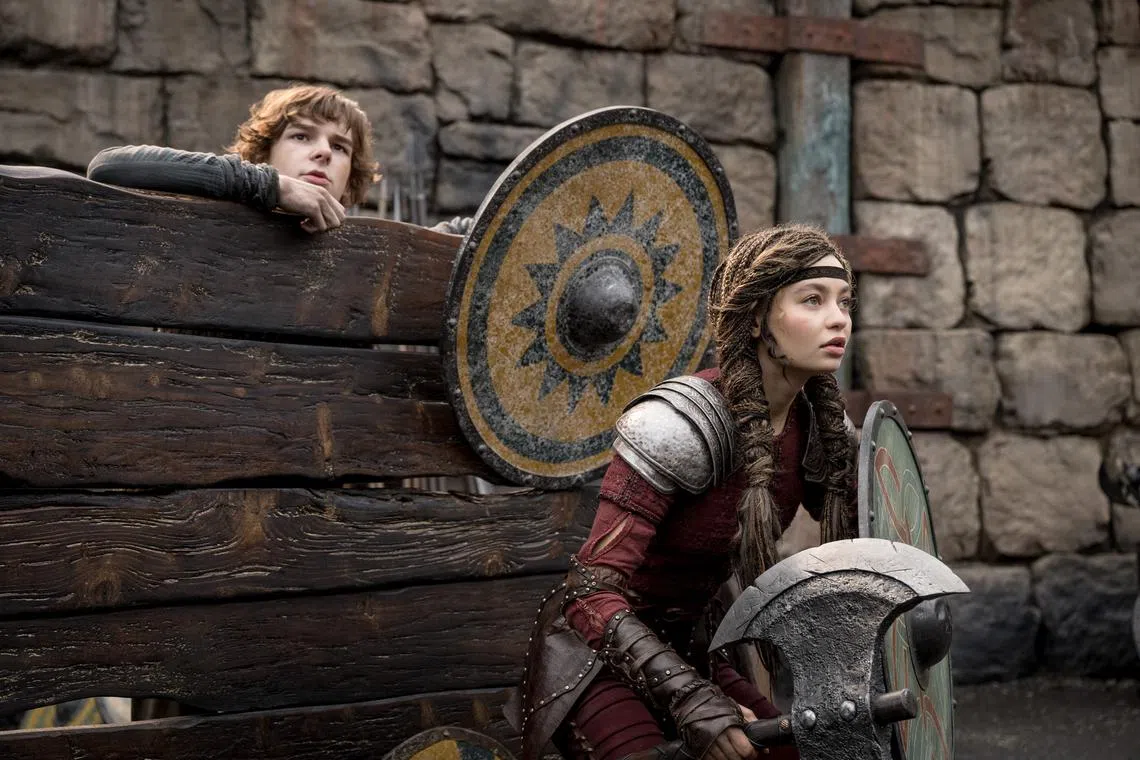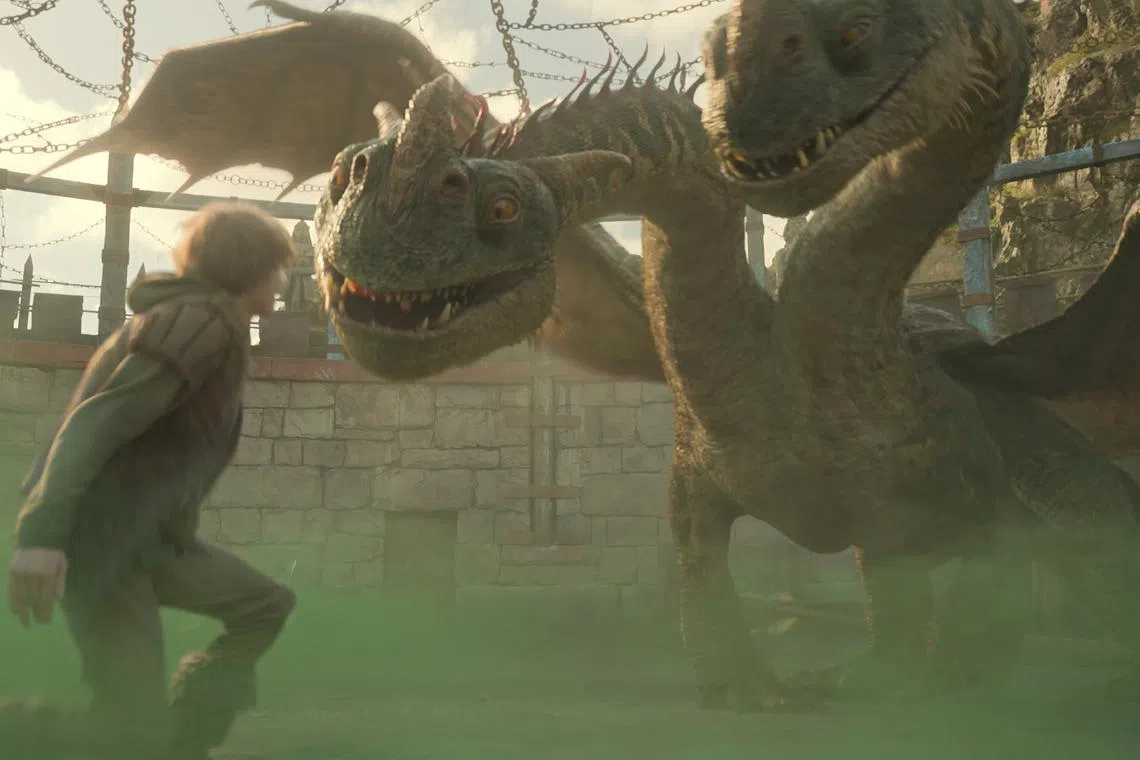Inside Universal’s big bet on How To Train Your Dragon, its first foray into live-action adaptations
Sign up now: Get ST's newsletters delivered to your inbox

Mason Thames as Hiccup with Toothless the dragon in How To Train Your Dragon.
PHOTO: UIP
Ashley Spencer
Follow topic:
NEW YORK – In 2020, Dean DeBlois publicly blasted live-action remakes of animated films as “lazy” studio endeavours.
The Canadian writer-director had, along with American film-maker Chris Sanders, made the 2002 Disney animated Lilo & Stitch and the 2010 DreamWorks Animation release How To Train Your Dragon.
DeBlois said he viewed such remakes as “a missed opportunity to put something original into the world”.
Then, two years later, he received a call from Universal Pictures president Peter Cramer asking if he would be interested in directing a live-action version of How To Train Your Dragon.
“At the expense of seeming like a hypocrite, I thought, well, I’m either going to sit here and pout and watch somebody else do it,” the 55-year-old said in a video interview, “or I could jump in and shoulder the blame or help to change the narrative.”
With the reboot – which is showing in Singapore cinemas – earning over US$197 million (S$252 million) worldwide, DeBlois is now enthusiastically attached to the type of movie he formerly criticised.

Director Dean DeBlois (left) and actor Gerard Butler at the premiere for How To Train Your Dragon in Los Angeles on June 7.
PHOTO: REUTERS
A lot could have gone wrong. He had never made a live-action feature before Universal put him in charge of the US$150-million remake, and the genre as a whole is facing increased scepticism from audiences and studios alike.
Yet, so pleased were the Universal executives after seeing a cut of the new Dragon, Mr Cramer said, that they rushed to greenlight a live-action adaptation of How To Train Your Dragon 2, to be directed and written by DeBlois and released in theatres in 2027.
How To Train Your Dragon – a retelling of the story of Hiccup, a pacifist Viking teenager who forms a bond with a once-feared dragon named Toothless on the Isle of Berk – represents the studio’s first foray into live-action adaptations of animated films.
Executives chose this property over Shrek (2001 to present) and Despicable Me (2010 to present) because of “the human and creature drama at the centre of it”, Mr Cramer said.
Surprisingly, the original Dragon was only the fifth most popular animated film of 2010, trailing Toy Story 3, Shrek Forever After, Tangled and Despicable Me.
But in the years since, the Dragon franchise – including two sequels in 2014 and 2019, which DeBlois wrote and directed – has found a large and devoted following.
The animated trilogy drew a combined US$1.65 billion at the global box office, and there have been three television spin-off series.
At Epic Universe, Universal’s newly opened theme park in Orlando, Florida, there is an entire Isle of Berk land with rides, a live stage show, dragon meet-and-greets and “Viking-ish” food.
Here is how the new movie took flight.
Widening the audience
When DeBlois worked on the animated How To Train Your Dragon, he recalled Jeffrey Katzenberg, the DreamWorks Animation chief at the time, frequently reminding him: “Don’t forget the five-year-olds” in the audience.
That was not the case this time.
Universal, whose parent company acquired DreamWorks Animation in 2016, was adamant that the new film cater not only to young viewers, but also to adults who had grown up with the original and those who had never heard of it.
“They were saying, ‘Embrace the fact that this is an all-audience movie. We want teenagers. We want people in their 20s,’” DeBlois said. “We were encouraged to think bigger.”
So, while still aiming for a PG rating, the crew built large-scale practical sets at Titanic Studios in Belfast, North Ireland, including a 360-degree Viking training arena, to shoot immersive action sequences.
English composer John Powell returned to make his sweeping score even more epic. And for those aerial shots and roller-coaster-esque flying sequences, the film-makers took a helicopter over Iceland, the Isle of Skye and the Faroe Islands to capture expansive footage, including of the craggly islet Tindholmur, which served as the basis for their fictional Berk.
Assembling the Vikings

Hiccup (Mason Thames, left) and Astrid (Nico Parker, right) in How To Train Your Dragon.
PHOTO: UIP
To embody the endearingly awkward Hiccup (originally voiced by Canadian actor Jay Baruchel), the film-makers cast Mason Thames, a Texas native who had starred in the Universal horror film The Black Phone (2021).
For Astrid, an ambitious Viking girl and Hiccup’s love interest, they selected biracial British actress Nico Parker, who had her big break in Disney’s 2019 live-action Dumbo remake.
Both 17-year-old Thames and 20-year-old Parker grew up as passionate fans of the animated Dragon trilogy. Thames once dressed as Hiccup for Halloween, and Parker – daughter of British actress Thandiwe Newton and British director-screenwriter Ol Parker – recalled going to see the original in theatres with her family four times.
When the cast was announced, however, some fans expressed outrage that Astrid would no longer be blonde and blue-eyed, as she had been portrayed in the animated films (though she was voiced by American actress America Ferrera, whose parents are from Honduras).
“It’s one thing if people just love the animated movies, and their version of a perfect live-action is a play-by-play with people who look exactly the same,” Parker said. “But when it comes from a place of real hate towards any kind of inclusivity, it’s not an opinion that keeps me up at night.”
In a rare move, Universal brought back Gerard Butler, who originally voiced Hiccup’s dad, Stoick the Vast, to reprise his role as the imposing chief of Berk.

Gerard Butler (left) and Toothless in How To Train Your Dragon.
PHOTO: UIP
The actor’s work on the original had involved simply saying his lines in a recording booth. This time, he spent hours each day getting a bushy chest-length beard applied before suiting up in 3D-printed armour with ancillary weapons.
“It was incredibly heavy,” the 55-year-old Scotsman said of the wardrobe. “The first time I put it on, I panicked that this whole movie was going to crash because Gerry Butler couldn’t handle the 90-pound (40kg) costume.”
Unleashing the dragons
Before Thames arrived on set in Belfast, he fretted that “it was just going to be a bunch of blue screens and a tennis ball as Toothless”, he said. Instead, the actors often performed opposite giant foam dragon heads and operational puppet bodies.
Then, to help digitally transform the dragons into believably menacing beasts, DeBlois turned to animation supervisor Glen McIntosh, an expert in paleontology who had animated dinosaurs in the Jurassic Park (1993 to present) franchise.
“Dean wanted the dragons to have the feeling that they were evolved animals, not creatures of fantasy,” McIntosh said. “So, even though they are creatures of fantasy, they had to look like they weren’t just cobbled together.”
Each dragon breed is, therefore, grounded in specific real-life animal traits. A Deadly Nadder like Stormfly, for instance, is influenced by the winged arms of a bat, the head of a parrot, and the legs and talons of a golden eagle.

Hiccup (Mason Thames) and the dragon Hideous Zippleback in How To Train Your Dragon.
PHOTO: UIP
And then there is Toothless. Unlike the fearsome menagerie that surrounds him, Toothless – a Night Fury with traits of a black panther and a salamander – needed to retain an extra layer of cuteness and relatability, while still looking as if he belonged in the same world as the others.
The animators spent 2½ years updating their hero creature. Toothless’ more cartoonish expressions, like raised eyebrows, were swopped out for head tilts or tail swishes that mimic those of a curious dog or cat.
As they added intricacies like textured scales, McIntosh said, their guiding mandate was always: “Is this something you would still want to pet?”
Looking ahead
DeBlois had considered opening the film with a new flashback from Stoick’s point of view. But the final cut faithfully follows its animated predecessor, including three shot-for-shot scenes.
Still, there are some subtle surprises, as when Astrid voices her desire to be chief of Berk one day, something that was never expressed in the animated version. It is a line that leaves open the possibility of future plot deviations.
“There’s an opportunity going forward to maybe colour outside of the lines a little bit more,” DeBlois said.
In May, the director was still drafting the Dragon sequel script, and he said there had not been any discussions about a third live-action film. Mr Cramer also could not “definitively answer” if Universal would complete the trilogy.
“We do have ambitions and hopes,” the studio head said. “But, you know, one movie at a time.” NYTIMES
How To Train Your Dragon is showing in Singapore cinemas.

